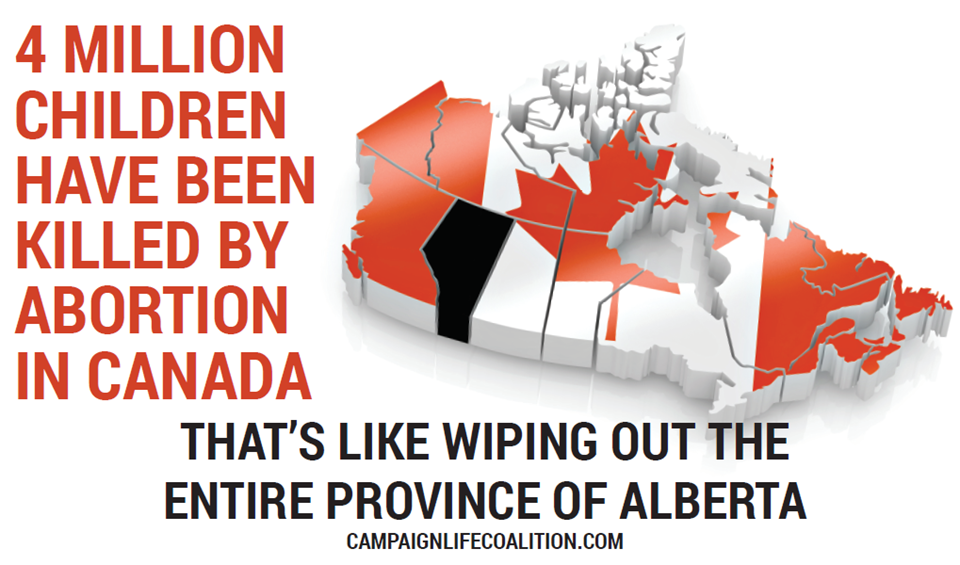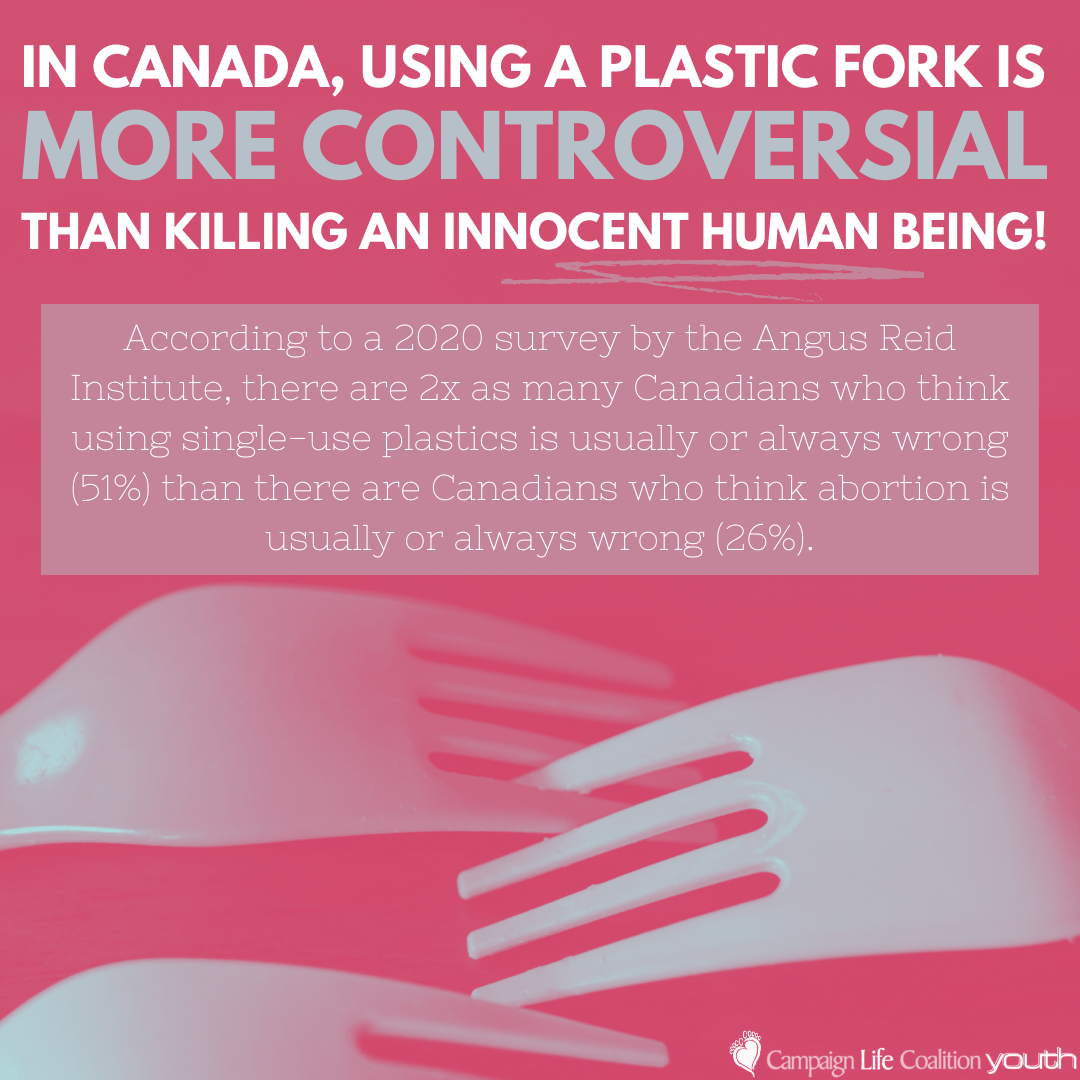
- Since 1969, abortion has killed over 4.5 million preborn babies in Canada.
- An estimated 100,000 induced abortions are committed annually in Canada.
- The Canadian Institute for Health Information (CIHI) reported 97,211 abortions in 2022, although CIHI acknowledges this data is incomplete. While hospitals are required to report the number of abortions committed, such reporting is voluntary for private abortion facilities. Abortions that aren't covered by the respective province's health insurance plan aren't necessarily included either.
- In Canada, approximately 1 baby is aborted for every 4 born alive.
- Almost a third of Canadian women over 45 are post-abortive.


- Abortion was permitted under certain conditions in 1969. Prior to this, committing an abortion was a crime under the Criminal Code.
- In R. v. Morgentaler, 1988, the Supreme Court of Canada made its landmark decision to throw out the 1969 abortion law on the basis that it was “unconstitutional,” ruling that the law’s detailed criteria for obtaining an abortion violated a woman’s Charter right to security of the person.
- Neither the Canadian Charter of Rights and Freedoms nor the Supreme Court of Canada established a right to abortion. The Supreme Court tasked Parliament in 1988 with creating a new law. This never happened, though an attempt was made in 1989 with Bill C-43 (An Act respecting abortion) that satisfied neither pro-life nor abortion advocates.
- Abortion still persists in a legal vacuum to this day, leaving the preborn with no legal protection.
- Section 223 of the Criminal Code of Canada states that a child only “becomes a human being” when it has “completely proceeded [...] from the body of its mother.” This section denies humanity to the preborn, stripping them of their right to life.
- This means that abortion is permitted throughout all nine months of pregnancy, for any reason or no reason whatsoever, up to the moment of birth.
- Canadian Parliament has voted down attempts to criminalize coerced abortions and sex-selective abortions. It has failed to protect preborn victims of crime who die in the womb when their mothers are assaulted or killed.
- Seven out of ten provinces — British Columbia, Alberta, Manitoba, Ontario, Quebec, Nova Scotia, and Newfoundland & Labrador — prohibit pro-life advocates from witnessing outside abortion facilities with “bubble zone” legislation. In late 2021, Saskatchewan prohibited protests outside hospitals and schools for two years, but not private abortion centres.

- Domestically, Canadians spend over $100 million on abortion every year ($1000+ x 100,000 abortions). $1000/abortion is a fairly conservative estimate, so the total cost, especially considering complications, is possibly significantly greater than $100 million.
- Abortions are funded with taxpayer dollars through every provincial health care system, despite the fact that polls show a majority of Canadians (67% in a 2011 poll) do not want their tax dollars going toward abortion unless it is a medical emergency.
- The Canada Health Act does not require abortion costs to be insured. It states only that "medically necessary" procedures must be insured. Abortions are never medically necessary – a fact that over 1000 medical professionals have attested to in the Dublin Declaration on Maternal Healthcare. Provincial legislatures can pass a law recognizing this fact at any time.
- Every province provides coverage for the chemical abortion product Mifegymiso.
- Canada spends $700 million/year internationally on “sexual and reproductive health and rights” (including abortion).

Unfortunately, there is an absence of data on why women choose to abort in Canada. Surveys conducted elsewhere, however, tend to reveal that women choose to abort for many reasons. While abortion activists argue for abortion by appealing to the “hard cases,” such hard cases are, at least in the United States, statistically rare.
Based on data spanning from 1996 to 2020 across several states and compiled by Human Life International:
- Less than 0.5% of abortions are due to rape and incest.
- Less than 1% of abortions are related to the physical health or disabilities of the fetus.
- Approximately 2.5% of abortions are related to the life or health (mental or physical) of the mother.
- Therefore, less than 4% of cases are due to “hard cases” and over 96% of abortions are due to social or economic reasons.
Even pro-abortion researchers have come to similar conclusions.
A 2013 BMC Women’s Health article based on data from the much-criticized Turnaway Study concluded that of abortions:
- 40% were related to financial reasons.
- 36% were related to bad timing for a pregnancy/baby.
- 31% were related to the mother’s relationship with the father of the baby.
- 29% were related to the mother’s perceived need to focus on her other children.
- 6% were related to “concern” for the mother’s health.
- 5% were related to “concern” for the health of the fetus.
The Guttmacher Institute, formerly the research arm of Planned Parenthood, found in a 2004 survey that of abortions:
- 1% were related to rape.
- 3% were primarily related to possible health problems of the fetus.
- 4% were primarily related to the physical health of the mother.
Some abortion advocates argue that abortion wouldn’t be necessary if there was better access to contraceptives. In reality, women often resort to abortion when their contraceptives fail, as no contraceptive method is 100% effective.
In fact, use of contraceptives leads to more, not fewer abortions. Abortion advocates admit the link between contraception use and abortion. “Most abortions result from failed contraception,” stated Joyce Arthur, founder and executive director of the Abortion Rights Coalition of Canada. Arthur’s statement parallels a prediction made in 1973 by Dr. Malcolm Potts, former medical director of the International Planned Parenthood Federation, who stated: “As people turn to contraception, there will be a rise, not a fall, in the abortion rate.” Even in 1955, controversial sexologist Alfred Kinsey stated that “we have found the highest frequency of induced abortions in the groups which, in general, most frequently uses contraception.”
According to studies conducted by the Guttmacher Institute, more than half of American women seeking abortions report using a contraceptive method in the month they became pregnant. The British Pregnancy Advisory Service (bpas) also reported that in 2016, over half of the women who had an abortion at their facilities were using a method of contraception – and a quarter were using hormonal or long-acting reversible methods, like the birth control pill or an IUD, which are typically praised for being more effective. Ann Furedi, former Chief Executive of bpas, said: “Abortion is birth control that women need when their regular method lets them down.”

- A 2020 survey by the Angus Reid Institute found that 26% of Canadians believe abortion to be usually or always wrong.
- A DART & Maru/Blue Voice Canada Poll, released in February 2020, found that of Canadians:
- Only 34% believe that human life begins at fertilization/conception - which is when science has proven that it begins. Conversely, only 18% of Canadians believe it begins at birth, which is the definition the Criminal Code of Canada uses.
- Just 13% identify as pro-life, while 62% identify as pro-choice, and 25% don’t identify with either category.
- 71% believe the government shouldn’t reopen the issue of abortion, but that’s without being asked about specific regulation.
- 93% think it should be required for women to be informed about the possible risks of abortion before procuring one.
- 84% oppose permitting the practice of sex-selective abortion.
- 78% think it should be required for women to be informed about alternatives to abortion before procuring one.
- 65% support a 24-hour waiting period before a woman can procure an abortion.
- 57% generally oppose partial-birth abortions, a late-term abortion procedure in which a preborn child is partially delivered before being killed.
- 49% believe minors should have parental consent before procuring an abortion.
- Read more about the poll results here.
- A 2019 poll by Public Square Research released by LifeCanada found that of Canadians:
- Only 16% believe abortion is acceptable for any reason.
- The Evangelical Fellowship of Canada have compiled polling results on abortion from 2007 to 2013 here.
- When responses are compared side-by-side, it’s evident they can vary significantly depending on the wording of the question. E.g. A 2010 Angus Reid Public Opinion poll found that when first informed that “Abortion is currently not regulated in Canada, meaning that a woman can legally have an abortion at any time during her pregnancy, with no restrictions” only 27% of Canadians support the status quo on abortion. However, when asked, “Do you think abortion should be legal under any circumstances, legal only under certain circumstances, or illegal in all circumstances?” 48% responded “any circumstances.”
- Various polls from 2008 to 2013 have revealed that the majority of Canadians believe abortion is legal only in the first three months of pregnancy.
- Various polls from 2007 to 2013 have revealed that only a minority of Canadians believe the taxpayer should fund abortions-on-demand, in every circumstance.

Updated: Feb. 07, 2025
